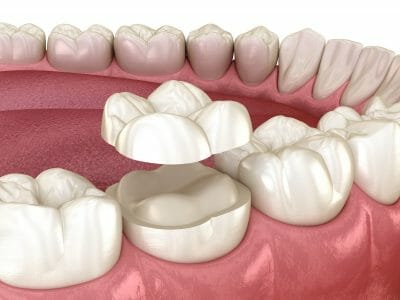Bonding, Inlays and Onlays
 What is enamel bonding?
What is enamel bonding?
Enamel bonding is a restorative dental procedure that uses a durable resin in a color that matches your natural tooth enamel to fill and restore areas of teeth that are damaged, such as teeth that have been chipped or broken.
The bonding consists of a composite resin that the dentist sculpts and polishes to look like a natural tooth. The resin is hardened and bonded to the tooth using a special blue light that cements it securely to the tooth’s surface.
Dental bonding may also be used for the following purposes:
- To fill in gaps between the teeth
- To fix the shape of a tooth
- To correct the color and appearance of stained or damaged teeth
- To make a tooth appear larger or longer
Enamel bonding may also be used as an alternative to traditional silver amalgam fillings to fill in cavities. For patients with receding gums and exposed tooth roots, dental bonding may be used to cover the root and protect it from decay and from sensitivity to hot and cold.
What are inlays and onlays?
Inlays are a special type of dental filling that fills in cavities and other minor damage to restore the shape and appearance of teeth, while onlays are used to treat more severe tooth damage. Both are bonded to the tooth to fill in the damaged portion. While an inlay will typically incorporate the tooth’s nooks and crannies, primarily restoring the chewing surface between the tooth’s eminences or cusps, an onlay covers one or more cusps.
What conditions are inlays and onlays used for?
Inlays and onlays are used to fill in and re-sculpt portions of teeth that have been damaged by decay, injury, or other causes. In particular, porcelain and resin onlays provide a durable and attractive solution that is difficult to achieve by other methods. Thanks to the natural look of porcelain, inlays look natural and attractive.
Because inlay and onlays are cemented to your teeth, they create a tight seal over your tooth, stabilizing the tooth and preventing further damage, infection, or inflammation. The bonding materials and porcelain used to make inlays and onlays are natural-looking and durable.
Inlays and onlays create a radiant and gleaming smile while restoring, stabilizing, strengthening, and protecting the teeth.
How is enamel bonding applied?
In preparation for the bonding process, the surface of the tooth must be roughened, then coated with a liquid that helps the composite resin adhere firmly to the tooth. The bonding material is applied like putty to fill in specific areas, and Dr. Harding carefully sculpts it to the desired shape.
Normally, the application of enamel bonding is painless and there is no need for anesthesia during the procedure, except in instances where drilling the tooth is required for any of the following reasons:
- To fill a cavity
- To alter the shape of the tooth
- To treat damage that is close to a nerve.
The composite resin used will be matched as closely as possible to the color of your natural tooth enamel.
To harden the composite resin, a bright blue light is used. This is to ensure a solid and durable finish that can resist the pressure exerted on the tooth when chewing. The material may be smoothed and shaped a bit further once it has hardened, and is then polished to match your natural tooth enamel.
If you’d like to learn more about how enamel bonding may improve the appearance and stability of your teeth and smile, contact our office to schedule an appointment with Dr. Harding.
